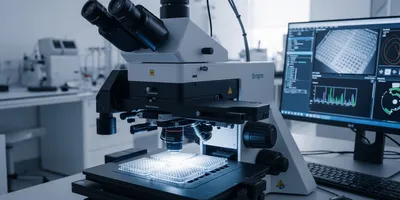Introduction: Why Technology Matters for Life-Science Labs
Life-science research is under pressure: more samples, more data, increasing demand for reproducibility, and tighter timelines. Automation has become a cornerstone—not just to save time, but to standardize workflows, reduce human variability, and enable richer data. Likewise, imaging technology has evolved far beyond “look through a microscope” to become a high-throughput, high-content, data-driven tool.
Recent insights into essential laboratory tools driving innovation highlight how instrumentation now underpins nearly every stage of discovery, from sample preparation to analysis. However, as labs adopt these advanced tools, the operational landscape becomes more complex. Managing instruments, users, and data pipelines at scale requires new strategies and digital infrastructure, echoing the principles outlined in data-driven laboratory management.
The sections below explore two technology areas transforming life-science workflows—automated liquid handling and imaging—and how they align with the evolving model of data-integrated laboratory operations.
Automated Liquid Handling: Precision, Throughput, and Reproducibility
The Case for Liquid-Handling Robotics
Manual pipetting and sample transfers are labor-intensive and prone to variability—especially at scale. Robotic liquid-handling systems accelerate tasks such as dispensing, dilution, plate setup, and NGS library prep while improving consistency and traceability.
Key advantages include:
- Reduced hands-on time, freeing scientists for higher-value work
- Improved accuracy and precision, even at microliter volumes
- Support for 96-, 384-, and 1536-well formats with uniform performance
- Seamless integration with LIMS, scheduling software, and sample-tracking systems
What’s New: Flexibility, Intelligence, and Miniaturization
Recent automation advances focus on flexibility and intelligence. Multi-purpose systems support diverse applications through modular decks and configurable tools. Intelligent features such as liquid-level sensing, tip verification, and real-time error detection are standard. Meanwhile, miniaturization enables micro- and nanoliter dispensing, vital for single-cell or organoid assays.
For lab managers, automation now represents more than just speed—it’s about control, traceability, and integration with digital infrastructure. Systems are being designed to self-diagnose, self-calibrate, and connect directly to centralized data hubs for audit-ready operations.
Implementation Tips for Lab Managers
- Choose open platforms with modular hardware and scripting flexibility.
- Integrate automation with data systems to maintain traceable sample lineage.
- Validate and monitor pipetting accuracy, deck calibration, and reagent performance.
- Plan throughput realistically—consider reagent prep, scheduling, and service cycles.
- Provide staff training on robotics troubleshooting and maintenance.
Imaging Advances: High-Content, High-Throughput, and Data-Rich
From Microscopes to Automated Imaging Ecosystems
Microscopy has become a data-generation engine. Automated imaging systems now capture and analyze thousands of samples with minimal human intervention, linking image data directly to assay metadata and analytics pipelines.
High-content imaging (HCI) platforms combine microscopy with automated image analysis, enabling phenotypic profiling and live-cell observation at unprecedented scale. This shift mirrors broader digitalization across lab workflows—where images are data, not just pictures.
Key Technology Trends
- High-Content Imaging (HCI): Combines fluorescence, confocal, and brightfield modes for quantitative cell-based assays.
- 3D and Live-Cell Imaging: Enables visualization of organoids and tissue models under physiological conditions.
- Machine Learning and AI: Automates segmentation, phenotype classification, and artifact correction.
- Workflow Integration: Imaging modules increasingly link to liquid handlers and plate movers, forming unified screening ecosystems.
This convergence of imaging and automation is driving next-generation workflows—imagine a single sequence in which a robotic system dispenses reagents, transfers a plate, captures images, and feeds the data to a cloud-based analysis platform. Such orchestration exemplifies how modern labs bridge physical and digital operations, aligning with strategies used in data-driven laboratory management.
Integrating Automation and Imaging in Data-Driven Labs
Introducing new instruments is only half the challenge—connecting them within operational and data frameworks is where transformative value emerges. In well-designed labs, automated liquid handlers and imaging platforms function as linked modules in an intelligent ecosystem.
Workflow Orchestration
Automation should extend from physical systems to software control. Integration platforms can trigger imaging runs automatically after sample preparation, ensuring traceable, timestamped datasets across instruments.
Data Architecture
A well-structured data backbone links every step: reagent lot, instrument ID, image set, and analysis output. This alignment underpins reproducibility and ensures that automated workflows contribute to a unified dataset rather than isolated silos.
Capacity and Scalability
Design for growth. Both automation and imaging should accommodate new assays and expanded throughput. Scalable platforms help prevent obsolescence as research priorities evolve.
Performance Monitoring
Dashboards that visualize run times, error rates, and data quality help lab managers evaluate efficiency and justify equipment ROI. Performance analytics are now central to the smart lab paradigm described in essential laboratory tools driving innovation.
Best Practices Checklist: Automation & Imaging for Life-Science Labs
☑️ Define clear goals for automation—throughput, precision, or reproducibility.
☑️ Choose flexible, modular systems with multi-application support.
☑️ Integrate automation and imaging with your LIMS and analytics pipeline.
☑️ Validate each new assay; monitor precision and drift over time.
☑️ Train staff to interpret machine data and troubleshoot automation errors.
☑️ Implement dashboards for real-time monitoring of run success and efficiency.
☑️ Incorporate feedback loops for continuous improvement and optimization.
☑️ Maintain preventive maintenance and revalidation schedules.
☑️ Ensure all data capture complies with traceability and integrity standards.
☑️ Align governance and SOPs to support integrated, data-centric operations.
Conclusion
Automation and imaging are redefining the modern life-science laboratory. Robotic liquid-handling systems deliver precision and reproducibility at scale, while advanced imaging platforms convert visual information into quantifiable biological insights. Together, these technologies enable labs to operate faster, smarter, and with greater consistency.
Lab Quality Management Certificate
The Lab Quality Management certificate is more than training—it’s a professional advantage.
Gain critical skills and IACET-approved CEUs that make a measurable difference.
For lab managers, success depends not just on adopting advanced instruments—but on integrating them within cohesive, data-driven ecosystems. Those that align automation, imaging, and information management will lead the next generation of scientific discovery.
This article was created with the assistance of Generative AI and has undergone editorial review before publishing.












